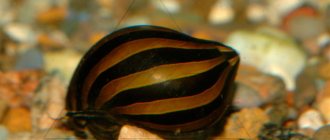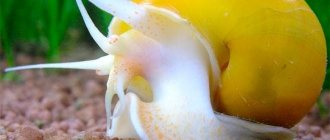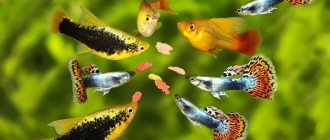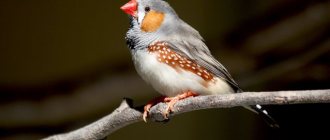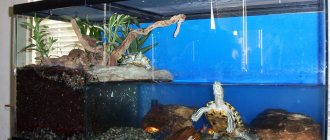Conditions of detention
The Helena snail needs fresh water with a high level of hardness, since it takes minerals for its shell from the environment. The pH level should be around 7-8. Softer water will cause the sink to soften or break. The clam will also do well in water with a low salt content.
For the comfortable existence of one individual, a volume of water of 2-3 liters is sufficient, but it is best to provide the mollusk with an aquarium of at least 20 liters.
| Volume of water (liters per 1 individual) | Temperature (°C) | Acidity (pH) | Hardness (dGH) |
| 2-3 | 21-23 | 7-8 | 8-15 |
Predatory snails prefer to burrow in sand, so they need to be provided with soft soil, very fine gravel or sand. To successfully grow and reproduce Helen snails, it is necessary to provide conditions that are as close to natural as possible. After birth, small mollusks are buried in soft soil and spend most of their childhood there.
Placing a small number of young shellfish in an aquarium immediately after acquisition can lead to the death of the entire population. To successfully combat ordinary snails using a biological method, the young animals should be raised a little in more favorable conditions, for example, a separate aquarium.
Helen's aquarium maintenance
These creatures are quite unpretentious and highly adaptable, but it is important to take into account their characteristics and preferences. The owner needs to take care of the following:
- Water quality . Helenas are freshwater inhabitants, which means that living in salty water can lead to their death. Even a small amount of salt causes frequent illnesses of these creatures. Like most hard-shelled mollusks and crustaceans, these snails require very hard water. When living in a soft water environment, individuals will not have enough minerals to maintain the strength and hardness of the shell.
- A container of suitable volume . Helenas are not particularly whimsical and can live even in a 3-liter jar. But if we talk about comfortable conditions, the tank should have a volume of at least 20 liters - this is important for the pet’s full movement and sufficient territory.
- Support of water indicators . For normal life, snails require water at a stable temperature - from 20° to 23°C. If the thermometer drops below +19°C, the predatory mollusk stops feeding and, during a prolonged cold spell, dies from exhaustion.
- Soil material . There must be soil in the snails' home; it is laid in a thick layer using soft material. The fact is that, after hunting, helens begin to burrow into it, remaining in this position until the food is completely digested. It is important to avoid the presence of particles with sharp edges in the soil; the snail’s leg is covered with delicate tissues that can be damaged very easily. In addition, ground material is necessary for young animals, who spend almost all of their time in it - helens hunt not only representatives of their own species, but also do not spare their relatives who have not reached their maximum size. It is best to use sand with large particles as soil. Experts warn that without this condition, predatory snails die.
Reproduction
The Helena snail is not a hermaphrodite. In order to achieve success in reproduction, you need to keep a large number of mollusks, since it is impossible to determine the gender of a particular individual by eye. With a large number of snail-eaters, there is every chance of raising a sufficient number of different-sex young animals.
Development of helena from eggs.
Stages of reproduction
- Formation of a couple. Two mollusks of opposite sexes form a pair and begin to mate. For Helen, the mating process can last several hours. Other mollusks may also join the pair. Sometimes the whole group sticks together.
- Laying eggs. A female individual lays only one egg on the surface of a stone or driftwood.
- Embryo development. This is quite a long process. Depending on the conditions, it can last from three to four weeks.
- The birth of a predatory mollusk. After the small predator hatches from the egg, it immediately falls to the bottom of the aquarium and buries itself in the ground for several months.
- The period from birth to puberty. From the moment the egg appears to the discovery of a young individual in the aquarium, about six months pass. Young mollusks emerge from the shelter after they reach a size of 8 mm.
Not all young mollusks reach 1 cm in size, when an individual can be considered an adult. Most of the young become victims of cannibalism and die in the struggle for food during the period when they live in the ground. Adult helenas do not eat small individuals.
Speeding up the process
One of the main conditions for the successful reproduction of predatory snails is water temperature. The optimal option is 23-25 °C. If the thermometer drops below 20, then the reproduction of mollusks stops.
It is better to keep small individuals in a separate pond until they reach a size of 10 mm. At this age, they will be able to withstand the competition of adult snails and reach sexual maturity.
In order to ensure the safety of the young, adults should be placed in a separate aquarium as soon as they have formed a pair. There they will mate and the female will lay an egg. One pair in favorable conditions can produce up to 300 young individuals per year.
A group of young helen snails.
In order to achieve good results in reproduction, Helen should be provided with a sufficient amount of food and a calm environment. In the presence of annoying neighbors, this type of mollusk temporarily stops the reproduction process.
It is quite easy to detect a pair that has already formed. Two snails begin to move around the aquarium without breaking physical contact. This process can last for weeks; the helenas do not separate even while eating.
Helena snail (Anentome helena)
Helena (Anentome helena)
is a beautiful and interesting species of freshwater predatory molluscs, which is very exciting to watch.
Helena is fundamentally different from other snails in that it is bred specifically to combat excessively multiplied physes, coils and melania. Small snails are Helen’s favorite delicacy and can easily cope with such a scourge.
Habitat:
In nature, they live in sandy areas in shallow, clean reservoirs and rivers in southeast Asia, Thailand, Malaysia and Indonesia.
Description:
Snails have a contrasting, spectacular shell color with clearly defined spiral dark chocolate stripes on an amber-yellow background. The cone-shaped shell itself has a ribbed surface. The body color is grayish with dark speckles.
Characteristic features of Helen are the elongated shape of the leg and the breathing tube, which the mollusk extends forward when moving. The mouth opening is adapted for opening the shells of other snails and is a small proboscis with a row of sharp teeth. To protect against danger, there is a small lid covering the sink.
The maximum size is 1.5-2 cm.
Content:
one individual can comfortably exist in a container of 3-5 liters, but it is preferable to provide it with more free space - from 20 liters. In this case, the snail will look much more expressive.
Helena (Anentome helena)
undemanding to water parameters, but it is advisable to keep them at 23-27 ° C; when the temperature drops below 20 ° C, the snails are not able to reproduce. Water hardness should be in the range of 8-15, and pH – 7.2-8. Too soft water contributes to the softening and destruction of the shell of mollusks.
Any plants can be planted; snails are indifferent to them, but the requirements for soil are quite strict. Helenas do not burrow completely into it like other species, but look for food there, and therefore fine gravel or sand is suitable for them.
They are not dangerous for fish and shrimp and cannot harm them due to their slowness. Helen cannot be kept in spawning grounds - the eggs and fry will be eaten.
It is also undesirable to plant newly purchased small snails in a common aquarium, they will not find enough food and may die, so it is better to wait until Helena reaches a suitable size (about 1 cm) and gains strength in a separate aquarium to begin to fight the “occupation” of small snails .
Nutrition:
If the aquarium has a lot of ground melania, physes, coils and other small mollusks, you don’t have to worry about Helen’s nutrition. In case of their absence or small quantities, it is necessary to feed predators with various types of food with a high protein content: daphnia, brine shrimp, bloodworms, frozen food, seafood, small pieces of minced chicken, worms.
Reproduction:
Helenas are not hermaphrodites and will require both sexes for successful breeding. The difficulty lies in the fact that sex cannot be determined externally and offspring can only be obtained by keeping a sufficient number of individuals together.
However, when a pair is formed, it is immediately noticeable: the snails stick together without parting even when they eat. At this point they can be removed. Breeding in a separate container is required only if mollusks are kept together with active or aggressive fish, such as cichlids, labyrinths, loaches and barbs. Helena will not lay eggs in their presence.
Otherwise, the process of their reproduction is quite simple and does not require special human intervention. After mating, the female lays one egg on any hard surface. These could be stones or decorative elements. The egg resembles a transparent pad, through which a tiny yellow ball can be seen. The development period of a snail depends on the temperature in the aquarium and lasts from 21 to 30 days. The hatched babies immediately hide in the ground, where they remain until they grow to 3-4 mm.
Helenas are able to reproduce at a size of 1 cm.
Average Helena predatory snail (Anentome helena)
lives in an aquarium for 2-5 years.
What do predators eat?
Helena snails in natural conditions feed on carrion and other types of snails, as well as insects. The main diet consists of physical and coils. The predator eats melanium less readily. Ampularia of any size can also become a victim of the snail eater.
Little Helena eats a large reel.
Helena has a thin tube that she inserts into the shell of another snail and sucks out its contents.
Caring for predatory snails is not particularly difficult. Snail eaters can be fed with food containing proteins, for example: worms, minced chicken, any seafood, daphnia or bloodworms. If there are a lot of small aquarium snails in the pond, then there is no need to worry about feeding the predator.
Living in the natural environment
Helena snails are native to Southeast Asia. Often these mollusks are bred to regulate the family of other, overly fertile snails. For Helen, they are a real delicacy, and they successfully exterminate them. In addition to them, they do not disdain to eat carrion, which makes individuals even more useful for an artificial reservoir.
Most of the representatives of the species prefer to live in flowing waters, but also quickly adapt to life in bodies of water without a current - in ponds and lakes. The latter allows them to quickly get used to aquarium conditions. Under natural conditions, these gastropods choose areas covered with sandy or muddy substrates for their life activities.
Helena are small mollusks, most often there are individuals with a shell of 1.5-1.9 cm, but it does not grow larger than 2 cm. They live for one and a half to two years, the duration of the life cycle is largely related to living conditions. They are found in Indonesian, Thai, and Malaysian reservoirs.
Who can keep snail eaters with?
The Helena snail can pose a danger only to slow-moving victims, most often small in size. Shrimps move quite quickly, and predatory mollusks can only be dangerous for those individuals that have recently undergone a molt. Therefore, if there are rare species of shrimp in the aquarium, you should be careful. Like all other shellfish, Helena can destroy eggs and fry that are unable to move quickly. You cannot let snails into spawning grounds!
A predatory snail can be kept in the same aquarium without any threat to its existence with fish. Helena can live in the same body of water with cichlids, barbs, loaches and other aggressive or overly active fish, but she will not reproduce.
Helenas maintain balance in the aquarium.
Snail eaters are used to maintain balance in the aquarium. The biological control method has received a large number of positive reviews. An overcrowded aquarium, or a complete absence of common snails, is not always desirable. A population of Helen snails or a single individual will help maintain the required number of other species of mollusks in the reservoir.
Description and photo of the predator
Helena's scientific names are "Anentome helena" and "Clea helena", the former belonging to the Asian varieties, the latter to the African ones. The advantage of purchasing a snail is not only its predatory ability to thoroughly clean the aquarium, but also its unusually beautiful appearance: a spectacular cone-shaped ribbed shell, amber-yellow in color with spiral dark chocolate stripes, and a greenish-gray body with dark inclusions.
Interesting and characteristic features of this freshwater mollusk are the oblong shape of the leg and respiratory tube, which extends forward when moving, as well as the oral cavity in the form of a proboscis with sharp teeth, with which Helena is able to open even the strongest snail shells.
Find out everything about caring for Achatina snails.
For its own safety, the predator uses a special lid that reliably covers its shell in any threatening moments.
After destroying all the extra snail-like mollusks, they begin to consume any other protein organic matter that has fallen to the bottom of the aquarium: leftover food and dead organisms.
Did you know? The maximum size of a snail, which was recorded in the world and entered into the Guinness Book of Records in 1976, is 0.3 m (this is the length of the shell) and 2 kg of weight.
The size of a predatory adult mollusk ranges from 1.5 to 2 cm in length.
Compatibility with other residents
Helenas are absolutely harmless to other inhabitants of the aquarium; they get along well with fish, ampularia, marises and some large species of mollusks: theodoxus and neritines. Shrimp are also not attacked - predators simply cannot keep up with them.
Important! After purchasing small snails, do not rush to place them immediately in a common aquarium - they will not be able to find a sufficient source of food for themselves. First, they need to be given time to strengthen and grow, at least up to 1 cm.
Snail breeding
The Helena snail is a heterosexual mollusk, therefore, for natural and successful reproduction, the aquarist needs to have several individuals in one home and take into account some simple breeding rules.
Is it possible to distinguish between a male and a female?
Unfortunately, it is impossible to independently distinguish the gender of predators. The only solution to obtaining numerous snail offspring is to initially keep a sufficient number of snails in one aquarium housing.
